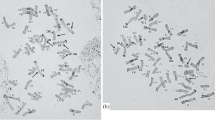Summary
-
1.
The karyotype of T. zhukovskyi, a hexaploid wheat recently recorded from Western Georgia of the U.S.S.R., revealed that it has 3 pairs of satellited chromosomes. Two of these resemble closely the two pairs present in T. timopheevi. The other pair is similar in arm ratio to the pair found in T. monococcum var. hornemanni. Micro-satellites usually found in varieties of T. monococcum did not occur in T. zhukovskyi.
-
2.
A maximum of 4 quadrivalents per cell was found at meiosis in T. zhukovskyi, the average being 1.35 per cell. Pollen and seed fertility were normal.
-
3.
In crosses between T. zhukovskyi and T. spelta, T. macha and T. vavilovi, only the F1 plants of the cross with spelta survived. There was an average frequency of 15.1 univalents per cell in the zhukovskyispelta hybrid. Thus, the partial failure of chromosome pairing in this hybrid is similar to that usually found in hybrids between T. timopheevi and other tetraploid species.
-
4.
From a discussion of the data, it is suggested that T. zhukovskyi might have arisen through chromosome doubling in the hybrid T. timopheevi × T. monococcum var. hornemanni. If this conclusion is supported by future experiments, T. zhukovskyi will be the first hexaploid wheat to have a genomic constitution other than ABD.
Similar content being viewed by others
References
Bell, G. D. H., Mary Lupton and R. Riley: Investigations in the Triticinae III. The morphological and field behaviour of the A2 generation of interspecific and intergeneirc amphidiploids. J. agri. Sci. 46, 199–231 (1955).
Bowden, W. M.: The taxonomy and nomenclature of wheats, barleys, and ryes and their wild relatives. Canad. J. Bot. 37, 657–684 (1959).
Chin, T. C., and C. S. Chwang: Cytological studies of hybrids with „Makha“ wheat. Bull. Torrey Bot. Club 71, 356–366 (1944).
Dobzhansky, T.: Genetics and the origin of species, 3rd ed. New York 1952.
Gaul, H.: A critical survey of genome analysis. Proc. First Int. Wheat Genet. Symp. 1959, pp. 194–206.
Jakubziner, M. M.: New wheat species. Proc. First. Int. Wheat Genet. Symp. 1959, pp. 207–220.
Kostoff, D.: Chromosome behaviour in Triticum hybrids and allied genera. I. Interspecific hybrids with T. timopheevi. Proc. Indian Acad. Sci. 5 — Bot. 231–236 (1937a); - Studies on the polyploid plants. XI. Amphidiploid Triticum timopheevi Zhuk. × Triticum monococcum L. Z. Pflanzenzücht. 21, 41–45 (1937b).
Kuckuck, H.: Neuere Arbeiten zur Entstehung der hexaploiden Kulturweizen. Z. Pflanzenzücht. 41, 205–226 (1959).
Lilienfeld, F. A., u. H. Kihara: Genomanalyse bei Triticum und Aegilops V. Cytologia (Tokyo) 6, 101–123 (1934).
MacKey, J.: The taxonomy of hexaploid wheat. Svensk bot. Tidskr. 48, 579–590 (1954).
Riley, R.: The diploidisation of polyploid wheat. Heredity 15, 407–429 (1960).
Roy, R. P.: Semi-lethal hybrids in crosses of species and synthetic amphidiploids of Triticum and Aegilops. Ind. J. Genet. Plant Breed. 15, 88–98 (1955).
Sachs, L.: Chromosome behaviour in species hybrids with Triticum timopheevi. Heredity 7, 49–58 (1953a);- The occurrence of hybrid semilethals and the cytology of Triticum macha and Triticum vavilovi. J. Agr. Sci. 43, 204–213 (1953b).
Sears, E. R.: The systematics, cytology and genetics of wheat. In: Handbuch der Pflanzenzüchtung, Bd. 2, S. 164–187. Berlin: Paul Parey 1959.
Stephens, S. G.: The genetics of Corky. II. Further studies on its genetic basis in relation to the general problem of interspecific isolation mechanism. J. Genet. 50, 9–20 (1950).
Swaminathan, M. S., and M. V. P. Rao: Macro-mutations and sub-specific differentiation in Triticum. Wheat Inform. Serv. (Kyoto) 6, 9–10 (1961).
Upadhya, M. D.: The use of α-bromonaphthalene, rapid hot fixation, and distributed pressure squashing for chromosomes of Triticinae. Stain Technol. (1963, in Press).
Wagenaar, E. B.: Studies on the genome constitution of T. timopheevi Zhuk. I. Evidence for genetic control of meiotic irregularities in tetraploid hybrids. Canad. J. Genet. Cytol. 3, 47–60 (1961).
Watanabe, Y., K. Mukade and K. Kokubun: Studies on the production of amphidiploids as the sources of resistance to leaf-rust in wheats. II. Cytogenetical studies on the F1 hybrids and the amphidiploids. T. timopheevi Zhuk. × T. monococcum L. [Japanese.] Jap. J. Breeding 6, 23–31 (1956).
— and S. Saito: Studies on the production of amphidiploids as the sources of resistance to leaf-rust in wheats. I. Cytogenetical studies on the F1 hybrids and the amphidiploids T. timopheevi Zhuk. x Ae. squarrosa L. [Japanese.] Jap. J. Breeding 5, 7–18 (1955).
Wilson, J. A., and W. M. Ross: Male sterility interaction of the T. aestivum nucleus and T. timopheevi cytoplasm. Wheat Inform. Serv. (Kyoto) 14, 29–31 (1962).
Author information
Authors and Affiliations
Rights and permissions
About this article
Cite this article
Upadhya, M.D., Swaminathan, M.S. Genome analysis in Triticum zhukovskyi, a new hexaploid wheat. Chromosoma 14, 589–600 (1963). https://doi.org/10.1007/BF00326513
Received:
Issue Date:
DOI: https://doi.org/10.1007/BF00326513



